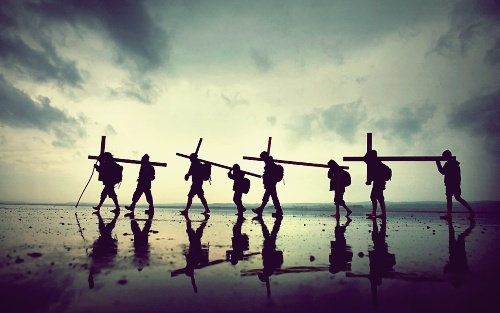
Reflection:
Jesus and his disciples left for the villages round Caesarea Philippi. On the way he put this question to his disciples, ‘Who do people say I am?’ And they told him. ‘John the Baptist,’ they said, ‘others Elijah; others again, one of the prophets.’ ‘But you,’ he asked, ‘who do you say I am?’ Peter spoke up and said to him, ‘You are the Christ.’ And he gave them strict orders not to tell anyone about him.
And he began to teach them that the Son of Man was destined to suffer grievously, to be rejected by the elders and the chief priests and the scribes, and to be put to death, and after three days to rise again; and he said all this quite openly. Then, taking him aside, Peter started to remonstrate with him. But, turning and seeing his disciples, he rebuked Peter and said to him, ‘Get behind me, Satan! Because the way you think is not God’s way but man’s.’
He called the people and his disciples to him and said, ‘If anyone wants to be a follower of mine, let him renounce himself and take up his cross and follow me. For anyone who wants to save his life will lose it; but anyone who loses his life for my sake, and for the sake of the gospel, will save it.’
Further Readings:
“… the Son of Man was destined to suffer … If anyone wants to be a follower of mine, let him renounce himself and take up his cross …” Words, very easy to understand but indeed as much hard to live! Fr Martin Cilia, in his book “Found Among Sinners” (pp. 128-130), tries to explore what was De Piro’s understanding of suffering and the cross and his living of this aspect of our discipleship of Jesus Christ:
The Cross: Power of the Missionary
One cannot speak of a truly Christo centric spirituality without a reference to the cross as the path to new life. De Piro calls the cross, “the most powerful arm against one’s enemies.” In line with Pauline theology he knew that the message of the missionary is “Christ and Christ crucified… power of God and the Wisdom of God.” Here lies the challenge to follow Christ. De Piro’s faith challenged him to see the cross as a sign of God’s presence. He held that:
To find his cross the Christian, does not need…to undertake long journeys and strain himself. What he has to find is not a material cross, but a spiritual one, which lies around him and behind him in such a way that if he were to flee from it or avoid it, he would not succeed.
Hans Kung says that, “Faith is challenged to see the cross as a sign of God’s presence in God’s very absence, as a sign of life through death. The following of Christ does not imply simply imitation. It means to act in a way analogous to and correlative with Christ’s way of acting… the message of Jesus Christ must always be translated.” De Piro, through his union with the Lord, was able to accept in faith the cross in his life. He was convinced of the Lord’s love: “Who will separate me from the love of God?” Even when caught in the web of meaningless and suffering De Piro never lost hope in the Lord.
This process of being one with Christ in his suffering meant for him absolute dependency on God. The cross of the Lord meant for him a deep conviction that in his insecurity, anxiety, darkness, loneliness and failure God was always there for him and with him. This attitude of trust is at its best when De Piro faced the death of some family members. He was well able to unite his humanity with his spirituality: “It is natural for us to weep when our heart is breaking with sorrow, but when God permits that we should suffer, this very grief becomes our treasure.”
The Cross made it possible for De Piro to see meaning in very difficult situations, to hope against all hope and to trust in his dreams and his call: “I thank God for visiting us, in the midst of our rejoicing, with some set-backs. After all, He is quite capable of using this mishap for the good of the work that is coming to life.” In the words of Hans Kung the virtue of hope inspired by the crucified Christ made him able not only to act but also to suffer, not merely to live but also to die.